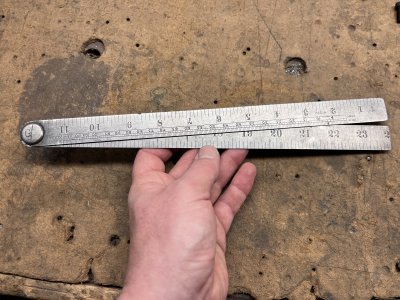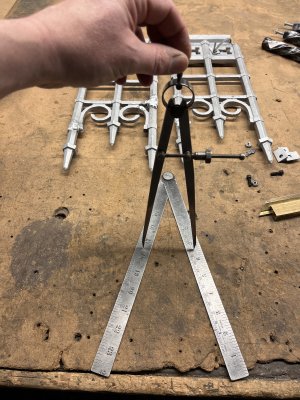Elektrishun
Active Member
Anyone have a unique tool, from any trade, that is not likely to be found in too many home shops? Antique, homemade, brought home from work after retiring as a Soviet cosmonaut?
I like handing this framing square over to people, especially carpenters or woodworkers, and then ask them what is unique about it. Even after some intense study, no one has ever said anything much more than, "It's kinda heavy."

My father-in-law found it at an auction and gave it to me without realizing what was special about it. I picked it up numerous times and looked it over without noticing anything other than the thickness of the metal which gave it that unusual weight for a framing square, even though it was an old one. One day, while looking at the maker's details stamped in the metal under a magnifying lamp, I noticed a curious little line where the body and tongue intersect that looked machine made...

1910 Jennings 100 C.E.J. & Co. Take Down Framing Square
There were many variations by many tool companies of these "take down" framing squares. Does not pull apart. Well, I can't pull it apart. A couple taps on the body with a wooden or rubber mallet gets it started. It is the only one I have seen in person and I have yet to meet someone who has seen one like it. Just about missed it altogether.
BTW, I am not a tool collector, more of a tool enthusiast.
I like handing this framing square over to people, especially carpenters or woodworkers, and then ask them what is unique about it. Even after some intense study, no one has ever said anything much more than, "It's kinda heavy."
My father-in-law found it at an auction and gave it to me without realizing what was special about it. I picked it up numerous times and looked it over without noticing anything other than the thickness of the metal which gave it that unusual weight for a framing square, even though it was an old one. One day, while looking at the maker's details stamped in the metal under a magnifying lamp, I noticed a curious little line where the body and tongue intersect that looked machine made...
1910 Jennings 100 C.E.J. & Co. Take Down Framing Square
There were many variations by many tool companies of these "take down" framing squares. Does not pull apart. Well, I can't pull it apart. A couple taps on the body with a wooden or rubber mallet gets it started. It is the only one I have seen in person and I have yet to meet someone who has seen one like it. Just about missed it altogether.
BTW, I am not a tool collector, more of a tool enthusiast.






